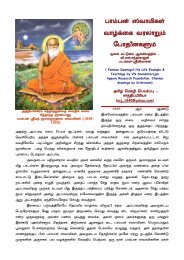MALAYSIAN HINDU PILGRIMAGE: KAVADI ... - Murugan Bhakti
MALAYSIAN HINDU PILGRIMAGE: KAVADI ... - Murugan Bhakti
MALAYSIAN HINDU PILGRIMAGE: KAVADI ... - Murugan Bhakti
You also want an ePaper? Increase the reach of your titles
YUMPU automatically turns print PDFs into web optimized ePapers that Google loves.
constituent elements organized hierarchically from the highest (at the head) and encompassed in thefiguration of a male with one head and two arms, the transcendent male principle that is identified withPurusa, Cosmic Man” (Handelman:p.143). Overwhelmed by <strong>Murugan</strong>’s effulgent brilliance,Surapadman was temporarily consumed with Divine Love, but when <strong>Murugan</strong> reverted to the form ofShanmugam (i.e. with six faces, twelve arms and twelve eyes), Surapadman assumed the form of amassive cannabalistic monster with a thousand arms and a thousand legs, and launched a frenziedattack. <strong>Murugan</strong> split Surapadman in two with his Vel, and Surapadman then took shape as a peacockand rooster both of which attacked <strong>Murugan</strong>. However, <strong>Murugan</strong> tamed them with a loving glance. Tocommemorate the defeat of the asura-s, <strong>Murugan</strong> ordered that the peacock and rooster shouldrespectively become his vahana (mount), and the emblem of his standard.Zvelibil (1991) has shown that all Tamil mythology is multivalent, and thus interpretable on severalplanes, namely as a story, metaphorically, and as a cosmological expression of metaphysical principlesand divine truths.At the cosmological level, this myth represents nothing less than the process of phenomenologicalentropy and dissolution, and its subsequent reconstitution and renewal. The Divine has two essentialstates. Being, the passive, is known as Siva, and becoming, the dynamic, is known as Sakti. These arepopularly envisaged as masculine and feminine respectively. Without the feminine aspect, Siva isremote and unknowable, and without the masculine aspect Sakti has no existence. The constantlyshifting relationship between Siva/Sakti (i.e. Absolute and Generative power) pervades all SaivaSiddhanta thought, and is held to operate on every level of cosmic awareness. Thus the conferral bySakti (Parvati) of the Vel, the instrument by which cosmic harmony is re-established, upon (the Sivacreated) <strong>Murugan</strong>, represents a manifest fusion of the Divine’s absolute and generative powers.At the metaphorical level the mythology has profound implications for the individual devotee, not leastthe resolution between the deity who is at once transcendent, the remote regulator of divine (cosmic)dharma, and imminent, closely involved with the affairs of the devotee. The battlefield is internalized,and the Vel becomes a symbol of the means to attain spiritual liberation. The “birth” of <strong>Murugan</strong> isrecognition of the yogic grace extended by Siva. <strong>Murugan</strong> is created by Siva to destroy the bondagesof ignorance imposed by the individual ego, but is furnished with the means to do this (the Sakti Vel)by Parvati. <strong>Murugan</strong> is perceived as the principle of Siva-Sakti in action within the substance of themind.The stages along the route to moksha (liberation) are clearly delineated within the mythology.Shanmugam, the initial, rather unwieldy, combination of manifest and unmanifest elements, representsthe first initial fumbling and undirected steps of the aspirant’s quest. As we have seen, Shanmugam isunstable, wilful and often instinctive. The instruction of Siva in the intrinsic meaning of the PravanaAum, the primordial unit of creation, indicates growing awareness of his divine powers, nature andidentity. This initial phase concludes with the bestowal of the Sakti-Vel, the spear of knowledge.<strong>Murugan</strong> sets off on his campaign from Mt. Kailas, divine home of Siva in the north of India, andpasses through six sacred cities before his final defeat of Surapadman at Tiruchendur in the extremesouth. Esoterically, north is held to symbolize Siva (Being/Absolute), while the South symbolizes Sakti(Becoming /Generative), while those locations in between are various combinations. The human bodyis seen as the replica of the universe, the north being at the crown of the head, the far south the souls ofthe feet, the centre at the base of the coccygeal plexus (the base of the spine). The region from head tofoot is divided into fourteen sections, representing the fourteen worlds. Each of these sections isconceived of metaphorically as a cakra, that is, a centre of psychic energy, regulating a dominantaspect of human unfoldment (Zvelebil:1973). Human spirituality emerges at the Muladhara Cakra,located at the base of the spine, and ascends through six psychic centres, the higher cakra-s. Access toand stablization within the Muladhara Cakra, and thus the prospect of further spiritual ascension, iscontrolled by <strong>Murugan</strong>’s younger brother, the elephant deity, Ganesha. <strong>Murugan</strong>’s descent from thenorth in response to the entreaties of his devotee and the granting of successive access to each of thehigher cakra-s (sacred cities), thus overcoming the counterpull of the seven worlds below thecoccygeal plexus, represents the progressive triumph of yogic knowledge over illusion.<strong>Murugan</strong>’s stablization, his progression to mature spiritual power proceeds as the divine campaignagainst the asura-s unfolds. The final battle between Surapadman (ego) and <strong>Murugan</strong> (universal


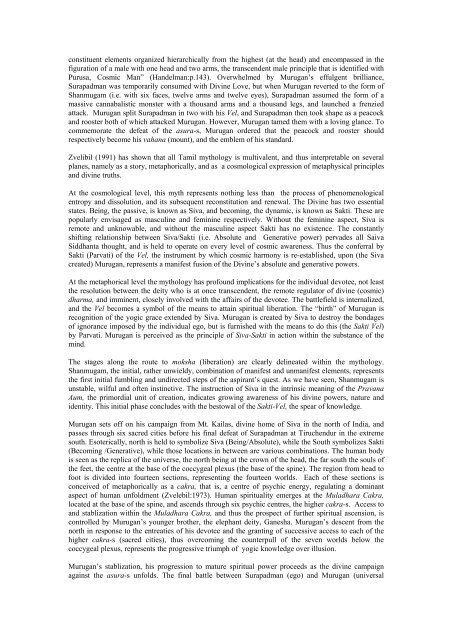
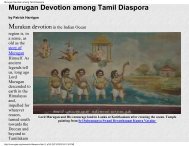
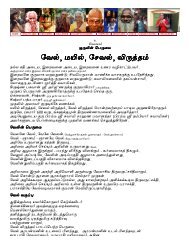
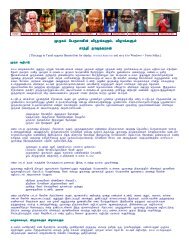
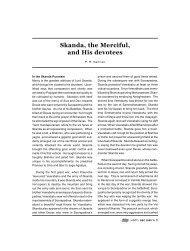
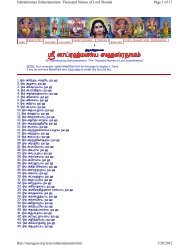
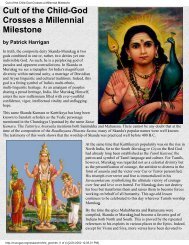
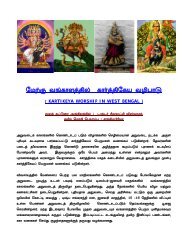
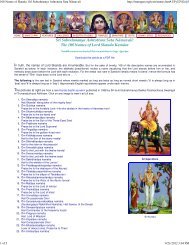
![gHdp k]y Myaj;jpw;F ghj ahj;jpiu fpuhkpa gHf;f Kiwfs;](https://img.yumpu.com/10245948/1/184x260/ghdp-ky-myajjpwf-ghj-ahjjpiu-fpuhkpa-ghff-kiwfs.jpg?quality=85)

